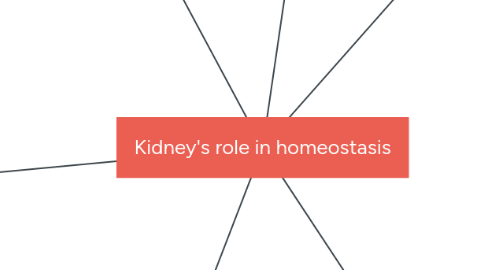
1. Case study: A 67 year old man has been in the hospital for 7 days now for congestive heart failure. Upon assessment, he experiences shortness of breath and fatigue. He appears to be confused asking where he is. Upon assessment, his urinary volume is below than normal (95mL). It is also noted that his blood pressure is quite low (92/40 mmHg). Upon reassessment 6 hours later, his urine output has declined making him oliguric.
2. Medical Diagnosis : Impaired urinary function related to acute renal injury (oliguric stage) as evidenced by shortness of breath, fatigue, confusion, low urinary volume (95mL), low blood pressure (92/40) and declination of urine output 6 hours later.
2.1. Stages of Acute Renal Injury
2.1.1. Initiating stage
2.1.1.1. Patient has bloody urine and experiences flank pain for the past 48 hours
2.1.2. Oliguric stage
2.1.2.1. This stage can last 5 to more than 15 days
2.1.2.2. There is a decrease in tubular transport, a decrease in urine formation, low GFR, patient is susceptible to bleeding and infection, patient has decreased urine output upon admission
2.1.2.3. Renal healing occurs - basement membrane is replaced with fibrous scar tissue, the nephron is clogged with inflammatory products
2.1.3. Diuretic stage
2.1.3.1. Kidney starts to regain its lost functions (depends on severity), signs and symptoms start disappearing, urine output will start to increase
2.1.4. Recovery stage
2.1.4.1. Kidney's basement membrane is restored with scar tissue and the structure and function are restored
2.1.4.2. This stage can last several months to over a year depending on severity
2.2. When all stages of Acute Kidney Injury are complete, homeostasis will be reached
3. Goals
3.1. Patient's vital signs will be within normal range
3.2. Patient will have a urine output within normal range (400-500mL)
3.3. Patient will
3.4. If patient’s kidneys do not improve, patient may need to undergo dialysis
4. Priority assessments
4.1. Take vital signs and assess for any pain
4.2. Assess mental status
4.2.1. Establish Project Objective
4.2.2. Establish Project Scope
4.2.3. Map Requirements
4.2.4. Map Solution
4.2.5. Map Training Requirement
4.2.6. Review Project Scope
4.3. Inspect retroperitoneal area (lower abdomen) for any raised areas, unusual pulsations, and inspect lower quadrant at midline for a distended bladder
4.3.1. Determine Project Approach, Stages and Steps
4.3.2. Estimate Project Duration
4.3.3. Establish Resource Requirements
4.3.4. Prepare Project Schedule and Budget
4.3.5. Prepare Work breakdown structure
4.3.6. Document Success Criteria
4.3.7. Review Project Schedule
4.4. Auscultate right and left abdomen midline at both upper quadrants for aortic or renal bruits
4.4.1. Identify Project Resources
4.4.2. Recruit Project Steering Committee
4.4.3. Recruit Project Coordinators
4.4.4. Identify / Recruit Key Stakeholders
4.4.5. Determine Training Requirements
4.4.6. Map the Project Organization Chart
4.4.7. Review Project Organization
4.5. Palpate for kidneys (not normal if palpable)
4.5.1. Establish Project Administration Procedures
4.5.2. Establish Quality Control Procedures
4.5.3. Establish Progress Control Procedures
4.5.4. Establish Change Control Procedures
4.5.5. Establish Issue Resolution Procedure
4.5.6. Review Project Control Procedures
4.6. Request for lab tests:
4.6.1. Urine – to determine presence of protein in urine, this is an indicator of renal function
4.6.2. GFR (Glomerular Filtration Rate) – estimates decreased function of kidneys
4.6.3. Blood tests – looks at overall function of the kidney
4.6.3.1. Serum creatinine, BUN, urea, nitrogen, phosphorus, potassium
4.6.4. Imaging studies
4.6.4.1. Ultrasound – helps to see any abnormalities in the kidneys
5. Nursing Diagnosis : Deficient fluid volume related to impaired urinary function
5.1. As evidenced by: patient has decreased urine output, patient is confused, experiences shortness of breath and is fatigue, patient has a low blood pressure reading (92/40mmHg)
5.1.1. Establish checkpoints
5.1.2. Acquire team resources for stage
5.1.3. Conduct stage kick-off meeting
6. Nursing interventions (with rationale)
6.1. Accurately record intake and output
6.1.1. Recording intake and output determines renal function and if the patient is at risk of fluid overload. This also informs the nurse if kidneys are functioning.
6.2. Take vital signs q4h and monitor blood pressure
6.2.1. Patient has a low blood pressure reading. Patient may be taking blood pressure medication prescribed by the doctor so it is important to monitor blood pressure for any changes.
6.3. Inspect skin
6.3.1. Nurse should inspect patient’s skin for dryness and cracking, this makes the patient at risk for infection.
6.4. Obtain lab results of electrolyte levels (potassium, calcium, sodium)
6.4.1. These values let the nurse know if the kidneys are functioning and excreting toxins.
6.4.2. Monitor sodium and potassium levels.
6.5. Assess level of consciousness
6.5.1. Patient may be restlessness due to changes in electrolyte levels and accumulation of toxins. Nurse should use safety measures (ie: raising side rails up or clearing pathway for patient) and reorient the patient (location, date and time).
6.6. Administer medications as ordered
6.6.1. NSAIDs - to help increase blood pressure as patient has a low blood pressure reading.
6.6.2. Inhaler – to help with lung expansion as patient is experiencing shortness of breath.
6.7. Prepare for intravenous fluids as ordered
6.7.1. To increase fluid volume in patient’s body, this will increase blood pressure
6.8. Increase fluid intake and eat food high in salt
6.8.1. To increase fluid volume in patient’s body, this will increase blood pressure. Eating food high in salt will retain water in the body and also increase patient’s blood pressure.
6.9. Give periods of rest
6.9.1. This allows patient to rest and conserve energy so patient won’t feel fatigued
6.10. Instruct patient breathing techniques
6.10.1. This allows patient to cope with shortness of breath.

